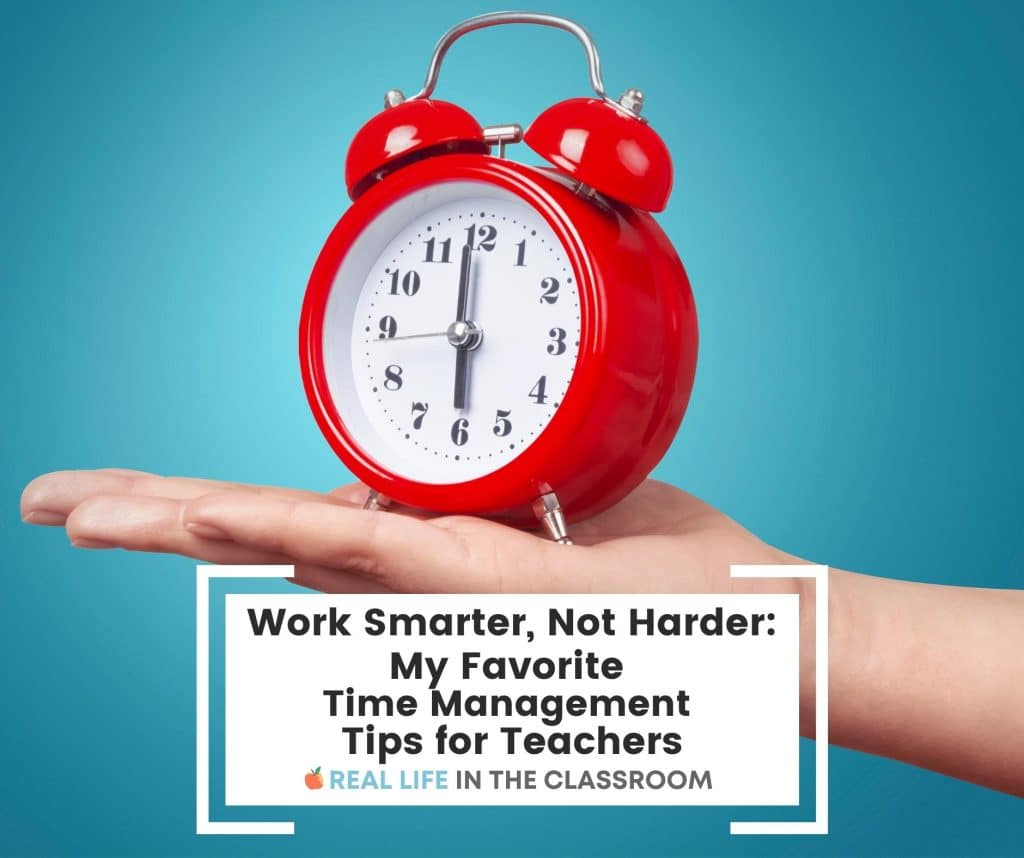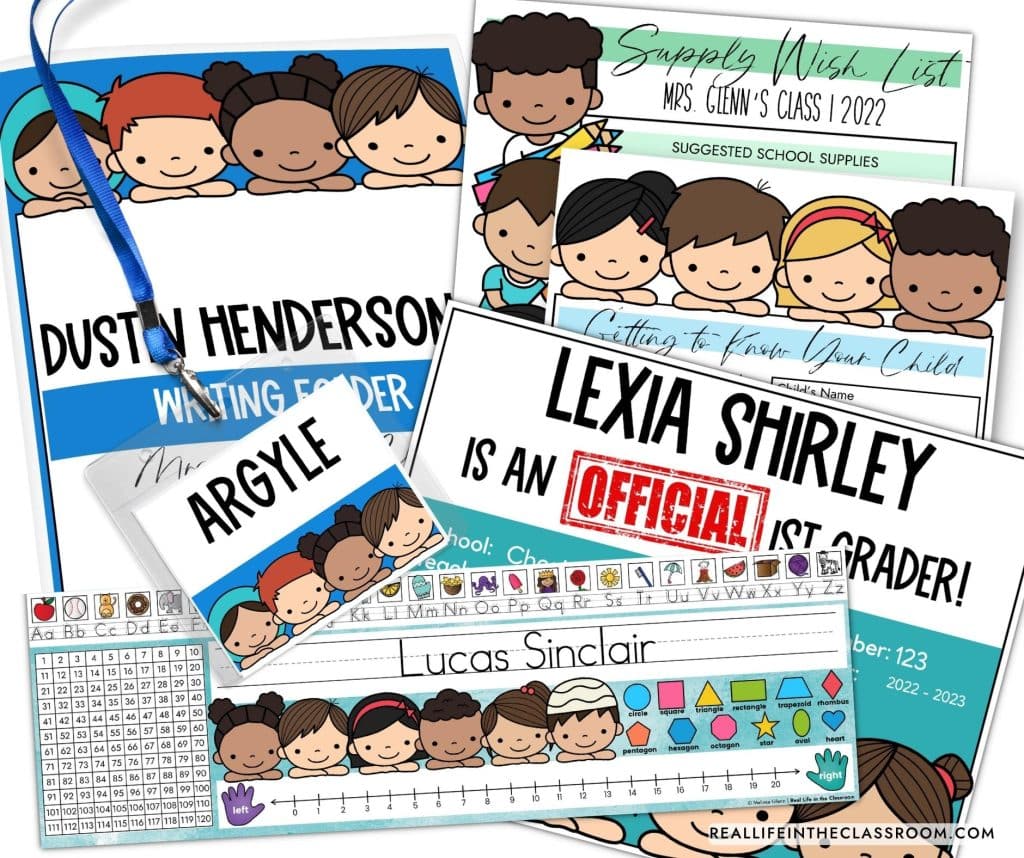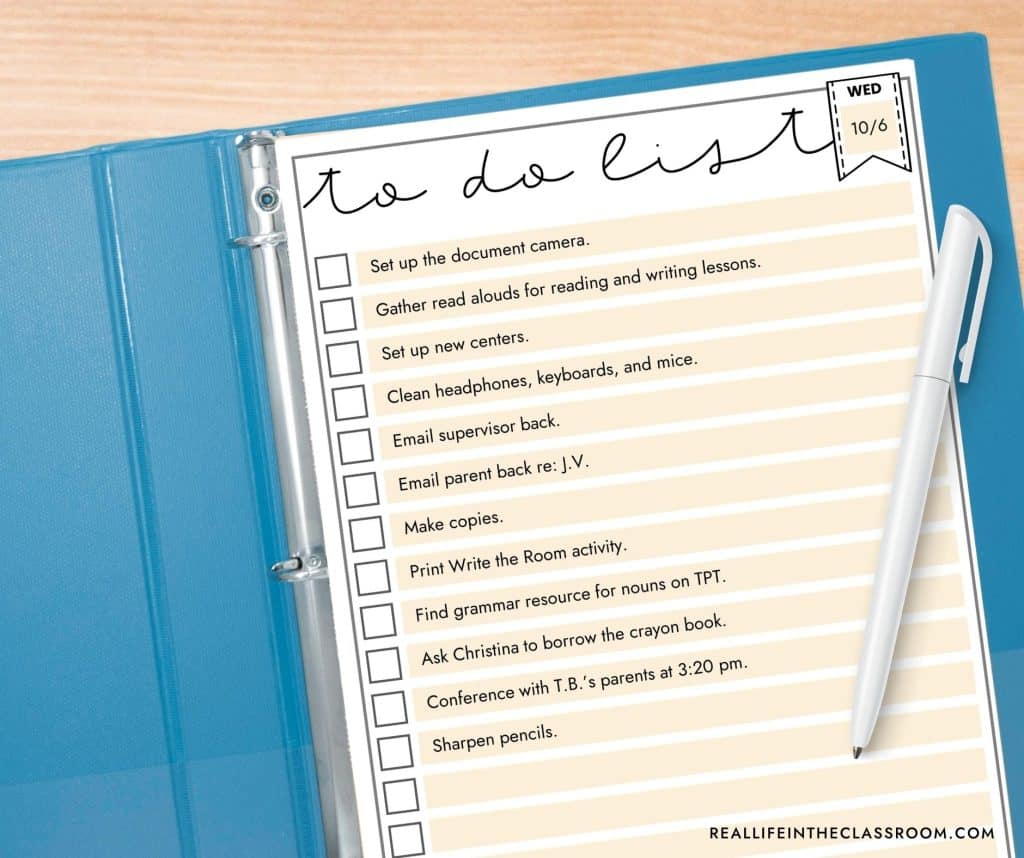Inside: Discover effective time management tips for teachers. From mastering batching to strategic grading, explore tips to work smarter, not harder.
I stared at the seemingly never-ending to-do list in front of me. The tasks were daunting: prepare learning centers, make copies, create slides, grade papers, decorate bulletin boards, schedule conferences, maintain portfolios… This list seemed to haunt my every waking hour.
Each day, I found myself still at school at 7 pm, long after my first graders had left. The echoing silence of empty classrooms only reminded me of the isolation that had begun to take over my life. My weekends morphed into workends. Friends? They hardly saw me anymore.
I wanted to give my students the very best I had to offer, but I kept forgetting one key player in the equation- myself. Teaching had become all-consuming, and it was becoming clear that I needed to change this unsustainable pattern.
They say that teachers are superheroes… but our list of superpowers sadly does not include manipulating time. (Wouldn’t it be AWESOME if it did, though?!) Yet, we’re constantly trying to stretch those 24 hours to accommodate all the things on our plates.
Here’s the good news. It doesn’t have to be like that. There are ways we can manage time more effectively. In this post, I’m excited to share some strategies that have truly made a difference in my own life. These time-management tips for teachers have been real game-changers for me, and I hope they will be for you too.

Table of Contents
1- Unleash Your Productivity Powerhouse with the Art of Batching
Let’s jump right into it. Batching. If you’ve never heard of it before the first thing you need to know is that it has nothing to do with cookies or baking. (Sorry, guys!)
Batching is a technique that can significantly enhance productivity and reduce mental clutter. It involves focusing on one type of task for a set period, helping to avoid the constant shifting between different tasks. It’s a fantastic strategy for lesson planning, prepping materials, and even grading papers.

Let’s take my Editable Welcome Back to School Template Bundle as an example. These templates have been designed to make your life easier—you can directly type student names onto the PDFs.
To effectively batch this process, first, you would download all of the PDFs onto your computer. Then, you would input all of the student names into the PDFs. Last you would print all of the pages you need from each of the PDFs. Prepping everything at once, as opposed to sporadically, can save you loads of time.

There are many tasks we do that can be batched to help you be more productive.
List of Tasks that Can Be Batched Effectively
- Lesson Planning: Spend a dedicated time each week or month planning out your lessons. Gather resources, design activities, and outline goals all in one sitting. You’ll avoid the daily scramble and ensure more coherent, structured lessons. You could take this a step further by batching by subject to help yourself get into a groove!
- Grading Assignments: Instead of grading each assignment as it comes in, set aside specific times to batch grade. You’ll find that you can get into a “grading groove,” making the process faster and more efficient. I liked to set aside time after school on Thursdays to grade all of the tests and important assignments from the previous week.
- Emails and Communication: Allocate specific time slots during the day for checking and responding to emails. The same applies to communicating with parents and colleagues. Email can be a black hole- this will help you from being sucked in continuously throughout the day!
- Prepping Materials: Whether it’s printing worksheets, gathering mentor texts, or prepping supplies, do it all in one batch. It’s way more efficient than setting up each day. Have a bin for each day of the week that you can place all of your materials into.
- Classroom Organization: Dedicate time each week for tidying up, restocking supplies, and organizing your teaching resources. You’ll feel more relaxed working in a classroom that is organized.
- Creating Classroom Materials: Whether it’s bulletin boards, anchor charts, or classroom decorations, create these materials in one sitting. Your creative juices will flow better, and you’ll save time.
- Entering Student Data: Instead of entering grades, attendance, or behavioral data sporadically, do it all at once. You’ll minimize the risk of errors and maintain better records.
- Parent Communication: Prepare newsletters, updates, and reminders for parents in one sitting. Doing so will ensure consistent, clear communication.
2- Time Mastery 101: Harnessing the Pomodoro Method
Have you ever noticed those adorable tomato-shaped kitchen timers? In Italian, ‘pomodoro’ means tomato, and that’s where this strategy gets its name. The Pomodoro Method involves setting a timer for 25 minutes (one ‘Pomodoro’), focusing on a single task during that time, and then taking a five-minute break. After four cycles, take a longer 15-minute break.

I swear by the Pomodoro Method—it keeps me off my phone and ensures I take necessary breaks to maintain productivity. You can use a regular kitchen timer, an app on your phone, or even a Chrome extension. An extension I use regularly is Focus To-Do: Pomodoro Timer and To-Do List. It’s a handy tool that integrates a Pomodoro timer with a to-do list.
I can get so much more done when I use a Pomodoro timer. If I’m tempted to get off task, I remind myself that I’m going to take a break at the end of the 25 minutes and that keeps me on track. It’s also a great way to remind yourself to get up and moving during a work session!
Pomodoro Apps:
- Forest: This app turns focusing into a game where you can plant virtual trees when you stay focused. If you exit the app before your time is up, your tree dies. (iPhone // Android)
- Be Focused: This app allows you to set tasks and customize the length of focus time and break times to suit your needs. (iPhone)
- Focus Productivity Timer: This is a combination of a Pomodoro timer and a task manager. It offers features like task organization, reminders, and reports to track your productivity. (iPhone)
- Focus Keeper: This app keeps the Pomodoro technique simple, allowing you to customize work session lengths, short breaks, and long breaks. (iPhone)
Pomodoro Extensions:
- Focus To-Do: Pomodoro Timer & To-Do List: This Chrome extension integrates a Pomodoro timer with a task management system, helping you focus on tasks, manage your time efficiently, and track your productivity.
- Marinara: Pomodoro Assistant: This extension is a flexible time management tool that uses the Pomodoro Technique, allowing users to choose from preset timer intervals or create their own. It also provides time history reports for tracking productivity.
- Strict Workflow: Enforcing the Pomodoro Technique with a twist, Strict Workflow blocks distracting websites during your 25-minute work periods and unblocks them for the 5-minute breaks, helping you stay focused and productive.
3- Smart Grading: A Strategic Approach to Evaluating Student Work
When it comes to grading, it’s important to pick your battles. In a perfect world, we’d meticulously grade every piece of work. But you and I both know that’s far from realistic or even necessary.
Strategic grading is a great time management tip for teachers as it involves focusing efforts on carefully checking only the most important assignments and checking all other work simply for completion. I’m not suggesting that you ignore student work- rather that you hone in on the work that will provide the most valuable insight into your students’ learning and understanding.

Strategic grading can reduce your grading time and help you focus on assignments that truly matter. Plus, it allows you to provide more detailed feedback where it matters most, which can enhance the learning experience for your students.
Assignments to Focus On:
- Unit assessments and quizzes
- Project-based assignments
- Writing assignments, like essays or reports
- Presentations and speeches
- Long-term assignments or research papers

Less critical work, like recording sheets for centers or certain homework assignments, should be checked for completion. This means checking to see they are done satisfactorily rather than spending a ton of time grading every detail. By grading strategically, you can focus more on students who need extra support and spend your time where it matters most.
Assignments to Check for Completion:
- Daily classwork or practice worksheets
- Homework assignments
- Recording sheets for centers
- Spelling or vocabulary practice
- Completion of online learning modules
- Daily reading logs
4- Empower Your Classroom: Delegating Responsibilities to Students
Consider this… you’re not alone in your classroom. You may not have ever thought of it this way before but your students can be your mini-sidekicks when it comes to saving time and managing the learning environment. Delegating appropriate tasks to students can free up your time, promote responsibility, and build a sense of community in your classroom.
There’s an array of tasks you can delegate, from classroom setup and clean-up to managing the classroom library, passing out papers, doing the lunch count, offering basic tech support, caring for plants, and even taking care of the class pet. Having students help in these tasks reduces your load and creates a collaborative, functioning classroom where everyone plays a part.

Tasks to Consider Delegating
- Classroom setup: Helping to prepare the classroom for the day by setting out materials or turning on computers.
- Classroom cleanup: Assisting in putting away materials, wiping down desks, or tidying up the classroom at the end of the day.
- Classroom library organization: Helping to keep the classroom library neat and organized by putting books back into the appropriate spots and selecting books with seasonal themes to display.
- Paper passing: Handing out or collecting papers during class.
- Lunch count: Keeping track of who is buying lunch and who brought lunch from home each day.
- Plant care: If the classroom has plants, a student or two could be responsible for watering them.
As you can see, involving students in everyday tasks isn’t just about saving time – it’s about building a supportive, responsible community right in your classroom. Trust me, you’ll appreciate the helping hands, and your students will enjoy the responsibility!
For more information on how giving students classroom jobs can improve the classroom environment, check out my blog post The Power of We: How Classroom Jobs Build a Stronger Community.
5- Leveraging Technology: The Secret Ingredient to Efficient Teaching
Taking advantage of technology can be a real game-changer for teachers, transforming and speeding up tasks that might otherwise eat up your day. Here are a few key examples:
Consider Seesaw, a student-driven digital portfolio that allows you to assign homework digitally. This is particularly useful when students have tech access at home. It not only minimizes paper clutter on your desk, but it also expands the range of assignments you can give. Also, it simplifies and quickens the process of checking student work while providing diverse methods for offering feedback. A feature I especially love is the ability to leave audio feedback. It’s not only time-efficient for us, but it also assists early readers who can focus on our words without the challenge of reading!

Another helpful resource is Google Forms, which can be your best friend when it comes to forms and surveys. No need to design, print, and send home paper forms—simply create a digital form, email it to parents, and watch responses come in real-time. It’s convenient, eco-friendly, and saves tons of time.
Effective communication with parents can be another time-consuming part of your teaching role. But apps like Bloomz, Class Dojo, or Remind are easy, efficient ways to keep parents informed, reducing the need for printed notices and improving engagement.

6- Winning Over Wasted Minutes: Effective Transition Planning
To boost productivity during class time, one important aspect to analyze is your transitions. The way transitions are managed can either drain valuable time and lead to chaos, or, with thoughtful planning, become a tool for efficiency.
You’d be surprised by how much time you can save by using smooth transitions. When implemented properly, your classroom can run like a well-oiled machine!
Having a transition song, using visual timers, giving a five-minute warning, and consistently using the same language for transitions can be incredibly effective. Teach explicit transition procedures and have quick transition activities ready to fill any downtime. Trust me, a little planning goes a long way here.

Fun Transition Ideas
- Sing a Transition Song: A simple song can do wonders for capturing attention. It could be about cleaning up, lining up, or even just sitting down. There are plenty of transition songs available online, or you can create your own.
- Dance it Out: Play a short, energetic song and encourage students to dance while they transition to the next task. They’ll get out some energy and be ready to refocus when the song ends. GoNoodle has tons of great videos that kids love to dance to!
- Follow the Leader: Play a game of follow the leader to the next activity. The leader can do silly movements that the rest of the class has to mimic.
- Animal Walks: Have students hop like a bunny, waddle like a penguin, or crawl like a bear to the next activity. This is not only fun, but it’s also great for developing gross motor skills.
- Silent Hand Clap: Teach students a special clap pattern. When they hear it, they know it’s time to transition.
- Magic Word: Have a magic word that signals a transition. It could be a fun, nonsensical word that you make up.
- Role-play: Transition by role-playing. For example, have children pretend to be astronauts if they’re moving to a space-themed activity.
- Countdown: Use a fun countdown to signal when the transition will happen. For example, “In 5, 4, 3, 2, 1… blastoff! Time to move to the reading rug!”
Prioritizing for Peak Performance
The classic to-do list—a simple, yet powerful tool for effective time management for teachers. Putting tasks on paper or on-screen can be incredibly freeing, lightening your mental load and reducing that nagging feeling that you’ve forgotten something.
And let’s not forget my absolute favorite part- the satisfaction of crossing out tasks on the list. I don’t know about you, but for me, it’s a small pleasure that reinforces my progress and motivates me to tackle the next task.
Plus, by recording tasks, we can allow ourselves peace of mind, especially at night when we’re trying to sleep. It’s on the list; we can deal with it during work hours.

To help you out, I’ve created a free set of To-Do Lists for Teachers. If you’re like me and type much faster than you write, you’re going to LOVE that you can type right onto these lists. Then, simply print them out and keep them on your desk so you can check things off as you get them done.
Your Journey to Masterful Time Management
Effective time management isn’t about packing more tasks into your day. It’s about simplifying, prioritizing, and making the most of the time you have. With strategies like batching, the Pomodoro method, strategic grading, student delegation, using technology, planning for transitions, and using to-do lists, we can reclaim our time and, yes, maybe even our weekends! 🙌
Try implementing some of these strategies to lighten your load and give yourself a little breathing room. And don’t forget to check out my Editable Welcome Back to School Template Bundle, and make sure to download the free set of Typable To-Do Lists for Teachers.
What is the scientific rationale behind the Batching technique?
Batching relies on the concept of ‘context switching,’ the mental process our brains undergo when shifting attention between different tasks. Each switch involves a cognitive cost as the brain reorients itself, leading to lost time and reduced efficiency. By focusing on one type of task in a dedicated time block, we minimize these switches, making our work more efficient and less mentally draining.
How can the Pomodoro technique aid in maintaining mental energy throughout the day?
The Pomodoro technique breaks work into manageable intervals (traditionally 25 minutes) separated by short breaks. This approach aligns with our brains’ natural attention span and energy levels, reducing fatigue and maintaining focus. The short breaks offer a necessary respite, allowing for a brief mental recharge before the next focused work period.
What is the pedagogical justification behind Strategic Grading?
Strategic grading is about focusing your efforts where they provide the most value. By concentrating on key assignments that provide significant insight into a student’s understanding, teachers can offer more meaningful and targeted feedback. This approach respects the fact that not all assignments are equally reflective of a student’s learning progress, allowing teachers to use their time more effectively and beneficially for their students.
What are some best practices for creating an effective To-Do List?
A well-structured to-do list should be clear, realistic, and prioritized. Start by listing all the tasks, then prioritize them based on urgency and importance. Avoid overloading the list; an endless list can feel overwhelming and demotivating. Break larger tasks into smaller, manageable steps to make progress more achievable. Regularly review and update the list to keep it current and useful. Remember, the purpose of a to-do list is to reduce stress, not add to it.
What other general tips can help teachers in managing their time more effectively?
Beyond the specific strategies mentioned in the post, teachers can benefit from setting clear boundaries to protect their time, regularly practicing self-care, seeking support from colleagues and administration when needed, and continuously reflecting on and adjusting their time management strategies to suit their evolving needs and circumstances. Remember, effective time management is a journey, not a destination.








